
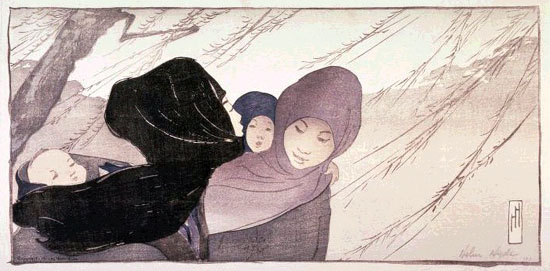 Helen Hyde (April 6, 1868 - May 13, 1919) was an American etcher and engraver. She is best known for her color etching process and woodblock prints reflecting Japanese women and children characterizations.
Helen Hyde (April 6, 1868 - May 13, 1919) was an American etcher and engraver. She is best known for her color etching process and woodblock prints reflecting Japanese women and children characterizations.
Born in Lima, New York, into a wealthy family. Helen Hyde moved to San Francisco with her family in 1870 where her wealthy father had built a business based on the Gold Rush. At twelve she began art instruction under Ferdinand Richardt for two years, a neighbour, and American-Danish artist in Oakland. But her studies ended abruptly two years later following the death of her father and her family resettled in San Francisco. Helen and her mother moved to Philadelphia and, after her graduation from Wellesley School, she returned to San Francisco and studied at the School of Design.
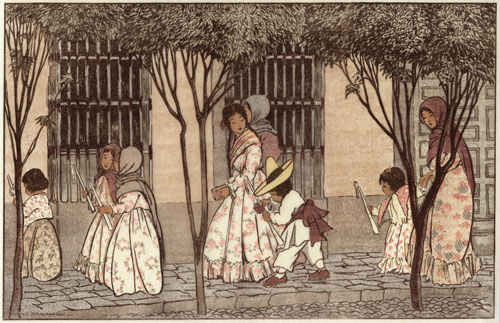
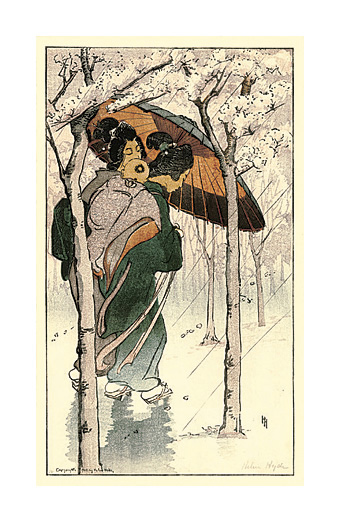
In 1882 her father died and her mother and sisters relocated to the home of her Aunt, Augusta Bixler. Between 1882 and 1888, Hyde continued her education by graduating from Wellesley School for Girls and attending the California School of Design. Between 1888·1894 she studied in New York City, Berlin and Paris where she met Felix Regamey, a Japonist who greatly influenced her development.
In 1890 Helen Hyde came to Europe, first a year in Berlin and then she spent three years in Paris, which at that time was considered the center of the fine arts world. She also spent several monthes in Holland and England. It was the period when the French impressionists had finally been accepted by the public after a long struggle. And it was the period of Japonism in France - a craze for everything Japanese, especially Japanese woodblock prints. In 1899 Hyde went to Japan where she rented a home in Tokyo, where she lived and worked. She studied with Kano Tomonobu, the last master of the Kano school of painting. She remained in Japan for 15 years.
After returning to Japan in 1912, Hyde remained only two more years. During that time, despite her declining health, Hyde continued to keep up a prodigious output of work, including woodblock prints, etchings and aquatints. In 1914, Hyde closed her Tokyo home and returned to the States to live with her sister in Chicago. Although she continued to produce etchings on her own, she could no longer produce woodblock prints without her carver and printer. Hyde lived and worked in Japan for most of her adult career and produced a sizable body of works largely depicting charming images of children.
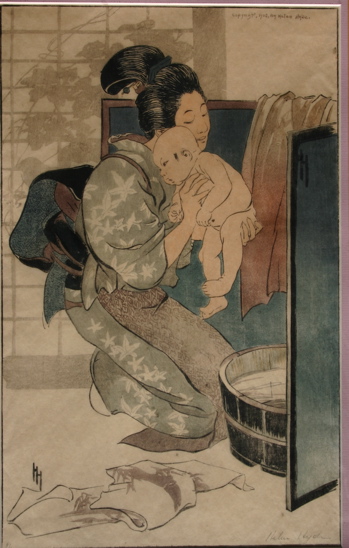
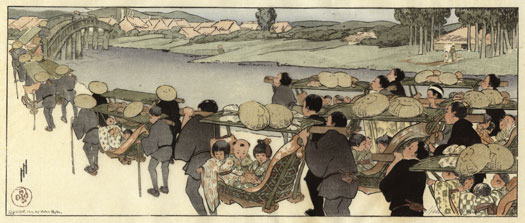 While Josephine Hyde returned to America, Helen Hyde continued her study in Japan in color woodblock printing. In Japan, Helen Hyde learned the Japanese woodblock printing techniques from masters such as Emil Orlik, a European living in Japan. Emil Orlik was Watanabe's first artist to cooperate in the realization of Watanabe's idea of a renewal of the old ukiyo-e tradition. This resulted in what we call today the shin hanga art movement.
While Josephine Hyde returned to America, Helen Hyde continued her study in Japan in color woodblock printing. In Japan, Helen Hyde learned the Japanese woodblock printing techniques from masters such as Emil Orlik, a European living in Japan. Emil Orlik was Watanabe's first artist to cooperate in the realization of Watanabe's idea of a renewal of the old ukiyo-e tradition. This resulted in what we call today the shin hanga art movement.
Hyde resided in Japan from 1903 through 1913 and refined color woodblock printing to a fine art. During this time, Hyde also traveled extensively to China, India, and Mexico. Around 1910 Helen Hyde learned that she had cancer. She closed her home in Japan in 1914, and left Japan, taking up residency in the United States where she lived with her sister in Chicago until her death on May 13,1919.
She was awarded the gold medal at the Alaska- Yukon-Pacific Exhibition in Seattle in 1909 and the bronze medal for woodcut at the Panama-Pacific International Exposition in 1915. Hyde was a member of the Chicago Society of Etchers, the Printmakers Society of California, the Chicago Society of Artists and a life member of the Société de la Grauvre en Couleur.

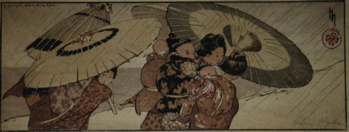
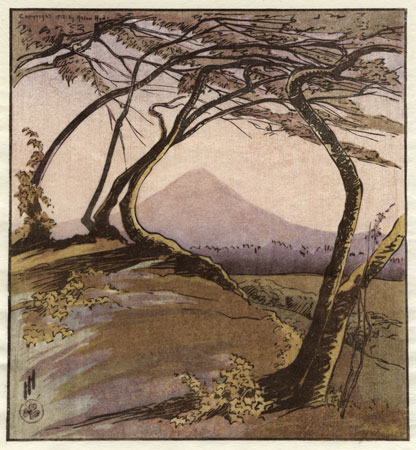
Tom & Alana Campbell 5214 South 2nd Avenue, Everett, Washington 98203-4113 Telephone (425) 252-2981